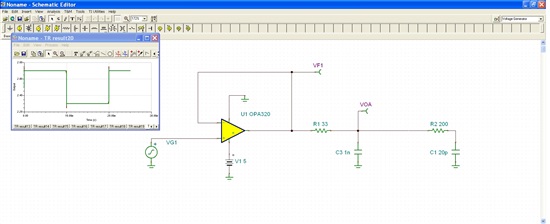Hello,
I have posted this as well as in Webench Design Center, I am not sure if it better fits there or here. I apologize in advance if doing it wrong posting it here too.
EDIT: Just got a reply from Webench Center.They helped me with TINA simulation but not with the methodology. So I am keeping the thread! ;)
http://e2e.ti.com/support/development_tools/webench_design_center/f/234/t/296289.aspx
New to TINA, I need help on a basic issue.
I intend to use OPA320 to drive ADC SM73201.
Traditional RC filter just after OPA and before ADC calculation suggested 33 ohms for Rflt and 1nF for Cflt.
I would like to check on OPA320 stability under this load before bench, and based on:
http://www.en-genius.net/includes/files/acqt_052906.pdf , pg 23.
that is part of very nice Tim Green's material Operational Amplifier Stability Series, I have in mind using modified OPA320 modified Aol curve to check stability looking at gain @ freq. closed loop and phase margin.
I came up with the following circuit:
According to the cited material Aol is VOA / VM. I couldn't find, however, a way to divide them. I found the "Add Sub Mult Div" block in Help -> Analog Control, but didn't find where it is in TINA. Not available in this version?
Using this method, what are ideal (traditional?) waveform and parameters for small signal input? Square wave, 280 mv, 1 VDC, 50 Hz ?
Anyway, how to get to modified Aol curve?
What other proved methods (besides implementing it physically!) for checking on op amp adc driver stability are there?
Thank you!






